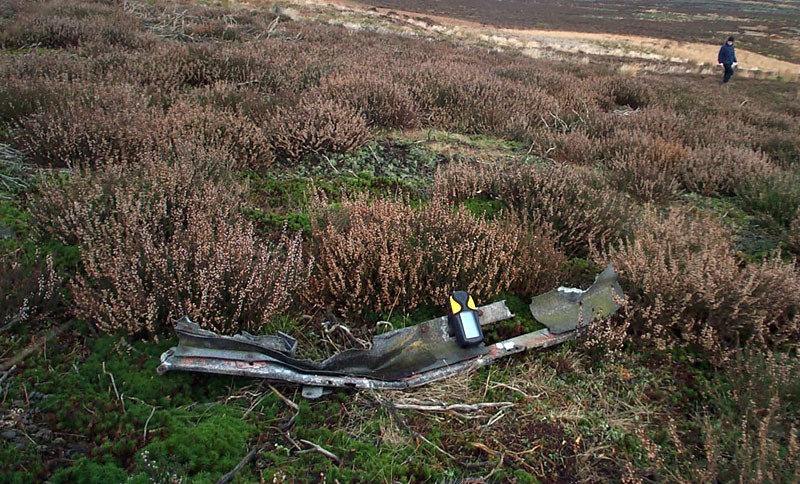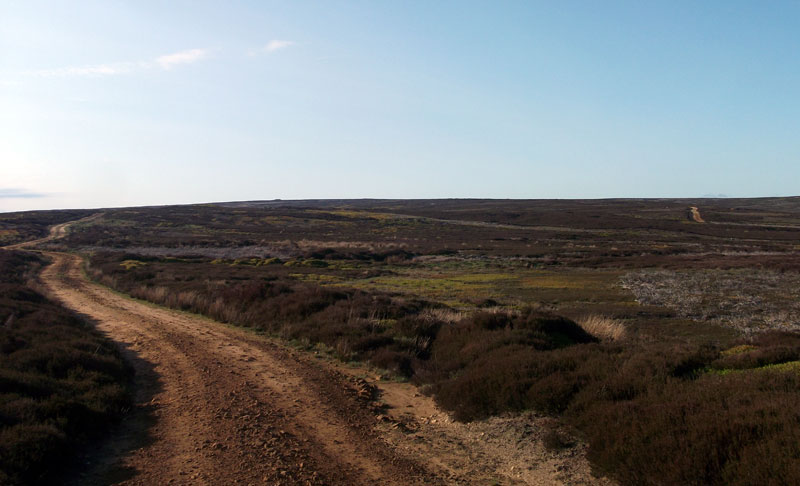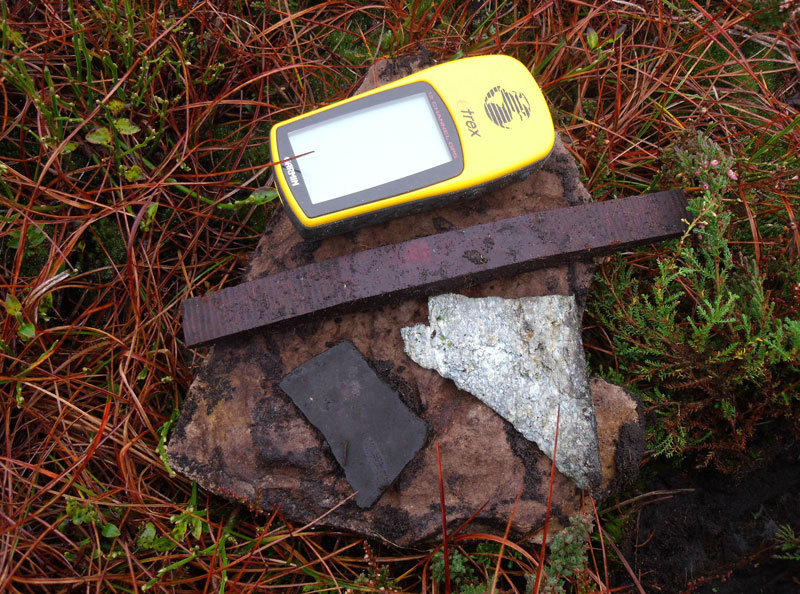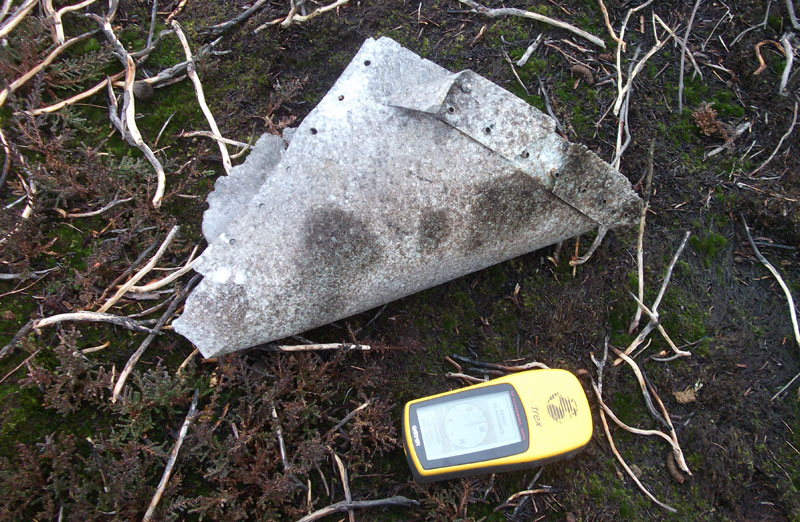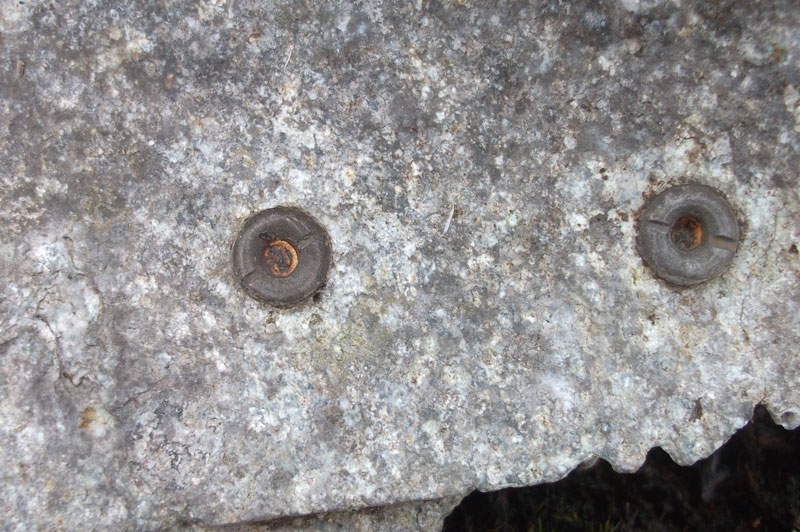At 19.15hrs on 13th October 1942 this 61 Squadron aircraft took off from Syerston airfield for an operational flight to bomb Kiel, some 288 aircraft of various types were tasked with the operation. The Germans operated a decoy fire site away from Kiel and this was partially successful in attracting at least half of the bombing force to drop their bombs in the open countryside, despite this forty one Germans were later reported as being killed on the ground. The Lancaster was damaged by flak over Germany which damaged some of the navigation equipment and flying instruments. In the early hours of 14th October 1942 on the return leg of the flight the crew of this aircraft became lost due to poor weather, and they flew too far north of their Lincolnshire base and over the North Yorkshire Moors. The aircraft was circling to obtain a position fix but was not flying high enough when it crashed into a fairly flat section of moor at just before 01.00hrs while flying through poor weather. The aircraft caught fire on crashing and would eventually burn itself out. The navigator on this flight volunteered to fly with this crew on this operational flight after the crew's regular navigator (Sgt N M Cymbalist) was unable to make the flight as he was sick. The replacement navigator was sadly one of those killed in the crash. One of the air gunners, Sgt Lund, is said to have struggled off the moor to a farm house, probably down into Bilsdale (or its branch of Tripsdale) and to Hagg House Farm with it being the nearest farm, where he raised the alarm. I have been told that he had broken both of his ankles so this was some feat in itself.
The seriously injured pilot and the flight engineer were later taken to the Adela Shaw Orthopaedic Hospital in Kirkbymoorside where the pilot then sadly died on 15th October 1942. It appears likely that a team from the 16th Light Field Ambulance unit based at Duncombe Park, Helmsley were despatched to the crash site because they are referred to in the casualty file. Those not killed or taken to hospital at Kirkbymoorside were taken to the sick quarters at this army unit at Duncombe Park.
The aircraft crashed at the summit of Todd Intake Moor at Crookstaff Hill, "Hagg House Moor" is widely quoted as the location but this reference probably relates to the location being the moorland above Hagg House. The RAF did a good job of clearing the site and probably what did remain has all but gone in later years. The area is within the Nawton Tower Estate and is well managed for grouse shooting.
Lancaster W4233 was built to contract B69274/40 by A.V.Roe Ltd in Manchester and was delivered directly to 61 Squadron at Syerston on 19th September 1942. The AM Form 78 states the aircraft was Cat.E/FB (Missing) on 14th October 1942 and it was not officially reported as "found" on the movement card. The aircraft was struck off charge on 14th October 1942 with total flying time of 47.25 hours.
Pilot - F/Sgt Henry Ernest Game RAFVR (1262786), aged 27, of West Southbourne, Bournemouth. Buried Bournemouth East Cemetery, Hampshire. Died of injuries on 15th October 1942.
Navigator - F/O Leonard Charles Robert Leach RCAF (J/7227), aged 21, of Dryden, Ontario, Canada. Buried Milland Churchyard, Sussex.
Bomb Aimer - Sgt Ronald Court RAFVR (1318105), aged 19, of Streatham, London. Buried Streatham Park Cemetery, London.
Flight Engineer - Sgt Harry Scattergood RAF (542849). Injured.
Wireless Operator / Air Gunner - Sgt Lawrence Sidney James Hamblett RAFVR (1187564), of Hove, Brighton and Hove, Sussex. Injured.
Mid Upper Gunner - Sgt Ernest Charles Hawkins RAFVR (1315038). Injured.
Rear Gunner - Sgt Edmund Thornley Lund RAFVR (994674), of Nelson, Lancashire. Injured, two broken ankles.
Leonard Leach and his gravestone in Milland, Sussex. He was born in Osaquan, Ontario, Canada on 11th November 1920 which was a sawmill community. He was the son of Charles and Hilda Annie (nee Weston) Leach. His father had fought in the First World War. The sawmill community disbanded in the early 1930's and he and his family moved to Dryden where he finished his schooling and later was worked in a bank when he enlisted into the RCAF in October 1940 in Fort William, Ontario. He completed his basic training in Canada and was awarded his observer's half-wings on 2nd August 1941 and was then granted a commission to the rank of P/O on 1st September 1941. He was posted overseas in December 1941 and continued his training at 9 (O)AFO beginning 10th March 1942 and 16 OTU beginning 4th May 1942. He was then posted to 61 Squadron on 11th July 1942. His hometown newspaper, the Dryden Observer, made mention on 7th August 1942 that on 3rd August 1942 he took part in a raid over Dusseldorf. "All of the nine Canadians were pleased with results and expressed joy in being able to make the trip over Germany" it stated, and "Of almost an hour's duration, the attack ruined about half of the munitions-making city" says the report. He may also have spent a short period of attachment to 44 CU, which was 44 Squadron's conversion training unit. While at 61 Squadron he had become the regular navigator of S/Ldr Peter Casement DSO DFC & Bar (44188). Leonard Leach's uncle Mr L C Weston lived in Liss, Hampshire, England and is probably why his grave is in nearby Millard Churchyard, Sussex.
Edmund Lund was born on 5th March 1915 at Bury, Lancashire and enlisted for RAF service in April 1940. He recovered from his injuries sustained in the accident on the North Yorkshire Moors. He received a commission to the rank of emergency P/O on probation on 23rd July 1943 and later rose to F/O. He was posted to 7 Squadron probably after completing a Tour with 61 Squadron and a period elsewhere but was sadly killed on 20th May 1944 when Lancaster ND736 was hit by light flak and exploded over Calais. He was twenty nine years old and is buried at Pas-de-Calais, France. A memorial window has been placed in his hometown parish church at St John's in Nelson, Lancashire on which his name appears. My thanks to historians Russell Brown for the photograph of him and to Alan Clark for the photograph of his gravestone.
Lawrence Hamblett was born in Brighton on 8th March 1920 and when he enlisted for RAF service in Hove on 30th August 1940 he was working as an auctioneers clerk. The Citation for his DFM reads "Sgt Hamblett who is now an air gunner, has completed a successful round of operational duty against targets in Germany, France and Italy. In spite of being involved in two serious crashes, one of which three members of his crew were killed, Sergeant Hamblett has remained undaunted in the face of enemy opposition. His efficiency has always been of the greatest possible assistance to his navigator and captain." Only five days after this accident on the North Yorkshire Moors he was married. As his DFM states, he was involved in a second accident (the details of this are yet to be learnt by this writer). As a W/O he was discharged from the RAF in 1945 through ill-health, whether this was down to injuries in this second accident or a third accident is not known. He returned home to Hove and died on 29th December 1996 at Worthing.
Harry Scattergood was born on 11th November 1919 in Salford and his mother later lived at Urmston, Manchester. He enlisted for RAF service on 11th August 1937 which would have been in the ground trades before he later remustered as aircrew. He fractured his skull as a result of the crash on the North Yorkshire Moors and was initially taken to the same Adela Shaw Orthopaedic Hospital in Kirkbymoorside as his pilot.
The only piece of aircraft found on my first trip to Hagg House Moor and possibly not from the Lancaster at all! This piece was some four feet long and could not have been wind-blown. Parts of
the nearby Wellington are known to have been scattered and carried far and wide to patch up stone walls, this piece is probably one of those that may have been dropped en route to such a wall.
As of July 2007 this piece had gone.
The general area of where the Lancaster crashed on Crookstaff Hill. The top photograph shows the general area while the bottom area shows a more closer view of the site. Very little remains
at the site today but because the aircraft probably slid along the ground for some distance the remaining fragments are farily widely scattered.
A collection of tiny fragments found on the surface when I visited in October 2009.
In 2016 I passed the area again and located a small piece with a good example of rivit !
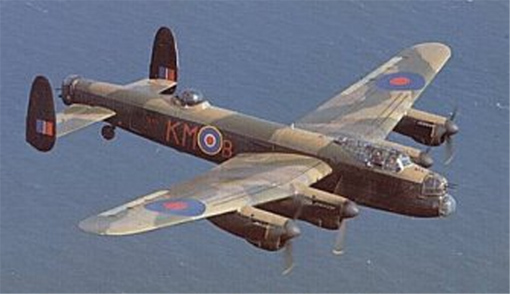
Henry Game was born at Leytonstone, Essex on 9th May 1915 and was married. He and the main part of this crew listed above were posted to 61 Sqduadron on 10th September 1942. Prior to this accident he had flown two "Dickie" operational flights with more experienced pilots then he and this crew listed above had flown one operational flight to Osnabruck on 6th October 1942 together. He had a total of 225 hours flying to his name, thirty eight hours of which were at night and twenty hours of those being on this type of Lancaster. He had also flown Manchesters, Wellingtons and Whitleys.
Ronald Court was born on 22nd January 1923 at Brixham, London and enlisted for RAF service in May 1941.
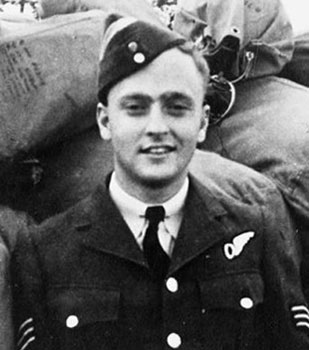

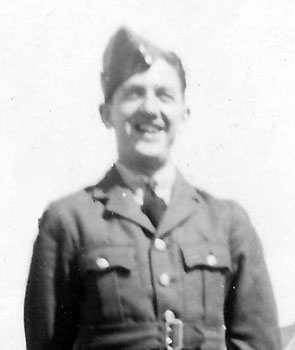
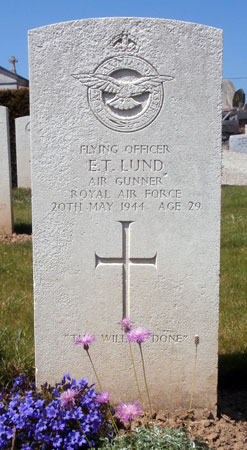
Lawrence Hamblett and Ernest Hawkins were awarded DFM's which were Gazetted on 17th August 1943, and were awarded for them both completing operational tours. Both airmen are believed to have survived the War.
John Skinn and I originally searched for the crash site in October 2002 and again in January 2003, we covered a large area of the Hagg House Moor which was at the time believed to have been
the crash location but only found one large piece of what was assumed to be an aircraft. This piece must be some way from the site of where any aircraft actually crashed and we failed to locate
where it must have come to a rest. It later became clear that the aircraft had not actually crashed on Hagg House Moor having purchased a death certificate of one of the fatalities which gave a
map reference for the crash site and John and I later searched Crookstaff Hill for any sign of the aircraft and located a few small fragments.
